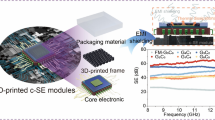Abstract
In recent years, radio frequency (RF) energy harvesting systems have gained significant interest as inexhaustible replacements for traditional batteries in RF identification and wireless sensor network nodes. This paper presents an ultra-low-power integrated RF energy harvesting circuit in a SMIC 65-nm standard CMOS process. The presented circuit mainly consists of an impedance-matching network, a 10-stage rectifier with order-2 threshold compensation and an ultra-low-power power manager unit (PMU). The PMU consists of a voltage sensor, a voltage limiter and a capacitor-less low-dropout regulator. In the charge mode, the power consumption of the proposed energy harvesting circuit is only 97 nA, and the RF input power can be as low as \(-\)21.4 dBm \((7.24\,\upmu \hbox {W})\). In the burst mode, the device can supply a 1.0-V DC output voltage with a maximum 10-mA load current. The simulated results demonstrate that the modified RF rectifier can obtain a maximum efficiency of 12 % with a 915-MHz RF input. The circuit can operate over a temperature range from \(-40\hbox { to }125\,^{\circ }\hbox {C}\) which exceeds the achievable temperature performance of previous RF energy harvesters in standard CMOS process.

















Similar content being viewed by others
References
J.F. Dickson, On-chip high-voltage generation in NMOS integrated circuits using an improved voltage multiplier technique. IEEE J. Solid State Circuits 11(3), 374–378 (1976)
T. Hirose, Y. Osaki, N. Kuroki, M. Numa, A nano-ampere current reference circuit and its temperature dependence control by using temperature characteristics of carrier mobilities. In: Proceedings of the ESSCIRC (2010), pp. 114–117
U. Karthaus, M. Fisher, Fully integrated passive UHF RFID transponder IC with 16.7 \(\upmu \text{ W }\) minimum RF input power. IEEE J. Solid State Circuits 38(10), 602–1608 (2003)
T. Le, K. Mayaram, T. Fiez, Efficient far-field radio frequency energy harvesting for passively powered sensor networks. IEEE J. Solid State Circuits 43(5), 1287–1302 (2008)
K.N. Leung et al., Analysis of multistage amplifier–frequency compensation. IEEE Trans. Circuit Syst. I 48(9), 1041–1056 (2001)
B. Li et al., An antenna co-design dual band RF energy harvester. IEEE Trans. Circuits Syst. I 60(12), 3256–3266 (2013)
H.O. Mahmoud et al., 5.2-GHz RF power harvester in 0.18-\(\upmu \text{ m }\) CMOS for implantable intraocular pressure monitoring. IEEE Trans. Microw. Theory Tech. 61(5), 2177–2184 (2013)
H. Nakamoto, D. Yamazaki, T. Yamamoto, H. Kurata, S. Yamada, K. Mukaida, T. Ninomiya, T. Ohkawa, S. Masui, K. Gotoh, A passive UHF RFID Tang LSI with 36.6 % efficiency CMOS-Only rectifier and current-mode demodulator in 0.35 um Fe-Ram technology. In: Proceedings of IEEE ISSC Conference (2006), pp. 1201–1210
U. Olgun, C. Chi-Chih, Investigation of rectenna array configurations for enhanced RF power harvesting. IEEE Antennas Wirel. Propag. Lett. 10, 262–265 (2011)
Y. Osaki, T. Hirose, N. Kuroki, M. Numa, 1.2-V supply, 100-nW, 1.09-V bandgap and 0.7-V supply, 52.5-nW, 0.55-V sub bandgap reference circuits for nano watt CMOS LSIs. IEEE J. Solid State Circuits 48(6), 1530–1538 (2013)
G. Papotto et al., A 90-nm CMOS threshold-compensated RF energy harvester. IEEE J. Solid State Circuits 46(9), 1985–1997 (2011)
G. Papotto et al., A 90-nm CMOS 5Mbps crystal-less RF-powered transceiver for wireless sensor network nodes. IEEE J. Solid State Circuits 49(2), 335–346 (2014)
H. Reinisch et al., An electro-magnetic energy harvesting system with 190 nW idle mode power consumption for a BAW based wireless sensor node. IEEE J. Solid State Circuits 46(7), 1728–1741 (2011)
A. Shameli, A. Safarian, A. Rofougaran, M. Rofougaran, F. De Flaviis, Power harvester design for passive UHF RFID tag using a voltage boosting technique. IEEE Trans. Microw. Theory Tech. 55(6), 1089–1097 (2007)
L.L. Xia et al., 56 V, \(-\)20 dBm RF-powered, multi-node wireless body area network system-on-a-chip with harvesting-efficiency tracking loop. IEEE J. Solid State Circuits 49(6), 1345–1355 (2014)
Acknowledgments
This work was supported by the National Natural Science Foundation of China (61376033, 61322405, and 61306044) and the National High-tech Program of China (2013AA014103).
Author information
Authors and Affiliations
Corresponding author
Rights and permissions
About this article
Cite this article
Liu, Lx., Mu, Jc., Ma, N. et al. An Ultra-Low-Power Integrated RF Energy Harvesting System in 65-nm CMOS Process. Circuits Syst Signal Process 35, 421–441 (2016). https://doi.org/10.1007/s00034-015-0092-7
Received:
Revised:
Accepted:
Published:
Issue Date:
DOI: https://doi.org/10.1007/s00034-015-0092-7




